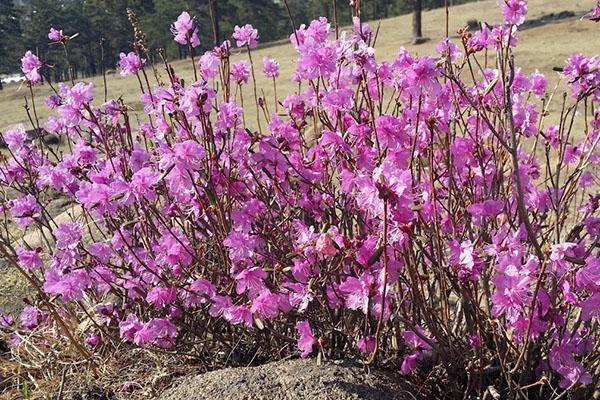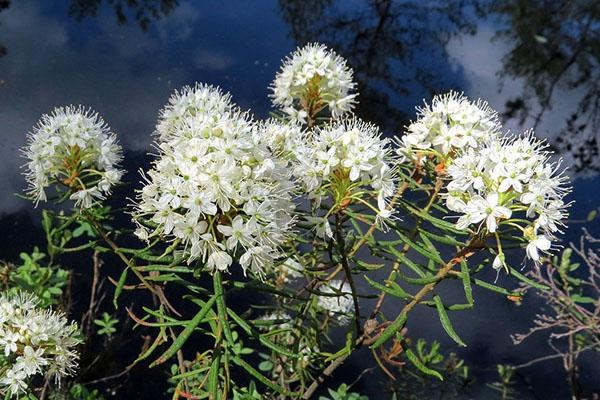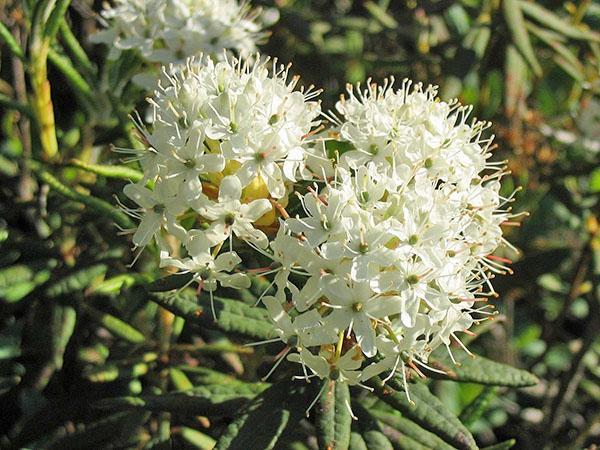How to grow a beautiful rosemary in the country
 Ledum in the country is grown by many gardeners. Its appearance is no less interesting than its origin. Scientists are still arguing about the generic affiliation of this plant. According to one of the versions, wild rosemary is considered a separate subgenus in the Heather family. Western botanists tend to classify it as a Rhododendron. Each of the versions has the right to exist. An interesting Latin name for the plant is Ledum. It came from the ancient Greek word translated as incense.
Ledum in the country is grown by many gardeners. Its appearance is no less interesting than its origin. Scientists are still arguing about the generic affiliation of this plant. According to one of the versions, wild rosemary is considered a separate subgenus in the Heather family. Western botanists tend to classify it as a Rhododendron. Each of the versions has the right to exist. An interesting Latin name for the plant is Ledum. It came from the ancient Greek word translated as incense.
Ledum is famous for its fragrant flowers. However, it is best not to be near them for a long time. It's all about essential oils with a high ice content. This is a specific poisonous substance that affects the human nervous system. It is impossible to make bouquets for the home from wild rosemary. But with proper care, it will become not only a decoration, but also a real protector for any garden.
Many are interested in where wild rosemary grows in the suburbs. This is a very unpretentious plant. It can even be found on swampy, acidic soil.
Ledum species
In summer cottages, only some types of wild rosemary are grown:
- Swamp. Prefers wetlands of coniferous forests and swamps proper. It also grows in peatlands. The height of the bush is from 60 cm to 1.2 m. It blooms from late spring to mid-summer with small umbrellas. It is resistant to cold, but rarely used in gardening, as it is very poisonous.

- Greenlandic. Loves the arctic climate. Most often it can be found on wet coasts, peat bogs and alpine slopes. Very common in the northern United States. The average size of the bush is from half a meter to a meter, the maximum is 2 m. The top of the leaf plate is wrinkled, and on the back there are white or brownish villi. This type of wild rosemary can withstand even the most severe frosts. Budding lasts only a month (from mid-June to late July). Since the wild rosemary of this species blooms with delicate white flowers, many owners of personal plots like to decorate their gardens.

- Creeping. The shortest representative of wild rosemary (only 20 - 30 cm). Lives in marshlands in mosses, as well as in tundra and sphagnum bogs high in the mountains. It is unpretentious to the soil. Another habitat is rocky placers and sandy hills. The leaves are elongated and narrow, slightly bent towards the bottom. They are relatively large (2 cm in diameter), but the flowering itself is rather modest.

- Large-leaved. Distributed in Japan, Korea, Siberia and the Far East. This species has a standard height (50 cm to 1.3 m). It blooms very profusely.

Where does wild rosemary grow in Siberia? He loves coniferous undergrowth, sphagnum bogs. The plant can often be found in dense heather thickets.
How to choose the right place and soil?
 Wet areas are ideal. Additionally, it is worth taking care of shading. Ledum does not tolerate the scorching sun rays. If they grow in the garden thuja or ate, next to them you can safely plant wild rosemary. The result is an excellent decorative effect.
Wet areas are ideal. Additionally, it is worth taking care of shading. Ledum does not tolerate the scorching sun rays. If they grow in the garden thuja or ate, next to them you can safely plant wild rosemary. The result is an excellent decorative effect.
It is better to select soil that is loose and with a high acidity index (pH 3 - 4). The planting mixture consists of three essential components: peat, coniferous soil and sand.
Ledum plantations in the country can not be placed near the apiary. The bees love this plant, but the collected nectar carries poisonous substances that will spoil all the honey. Its use by humans will become unsafe.We'll have to resort to boiling.
Ledum in the country: the subtleties of planting
 Planting and caring for wild rosemary in the Moscow region is not very different from other regions. It is best to start planting in the spring. For seedlings with a closed root system, time does not really matter. Ledum is generally a rather unpretentious plant that easily tolerates cold.
Planting and caring for wild rosemary in the Moscow region is not very different from other regions. It is best to start planting in the spring. For seedlings with a closed root system, time does not really matter. Ledum is generally a rather unpretentious plant that easily tolerates cold.
First, you need to prepare the pit. Usually, most of the rosemary roots are buried by 20 cm. In this case, the total depth of the pit is at least 40 and not more than 60 cm. The rosemary shrub will grow in one place for a long time. The bottom is covered with a 5 cm drainage layer (sand + river pebbles). Then the plant is placed and sprinkled on top with a pre-prepared mixture. After that, the soil must be watered and mulch.
It is permissible to plant several bushes in one hole. You just need to observe the optimal distance between the holes - 60-70 cm.
Further care
 Caring for wild rosemary at home is very simple. It includes traditional events.
Caring for wild rosemary at home is very simple. It includes traditional events.
The plant regularly needs:
- Watering. At least 2 - 3 times a month. For this, acidified water is used. This makes it easier to maintain an optimal pH level. In a dry, hot summer, more frequent moisture is required (once every 7 days). One bush takes 5 - 8 liters of water. After each watering, loosening and mulching are carried out so that the moisture does not evaporate longer. It is not advisable to allow waterlogging or drying out of the soil. Both of these extremes are fatal for wild rosemary.
- Top dressing. It is brought in in the spring, once a season is enough. Take 50 - 70 g of complete mineral fertilizer per meter2... For young specimens, the dose is reduced to 30-40 g.
- Pruning and disease. There is no need to specially form the bushes. Get rid of only dry dead branches. As for diseases and pests, wild rosemary has strong immunity, and aromatic essential oils scare away harmful insects.
Reproduction
Breeding wild rosemary in the country is a rather painstaking task. This can be done in several ways.
Seeds
 Collect them with the arrival of autumn. They are collected in special hanging boxes. Sowing begins at the very beginning of spring. The container is filled with loose earth with sand, and seeds are laid on top of it. Next, the containers are sealed with foil and kept cool. Care is the same as for any other seedlings.
Collect them with the arrival of autumn. They are collected in special hanging boxes. Sowing begins at the very beginning of spring. The container is filled with loose earth with sand, and seeds are laid on top of it. Next, the containers are sealed with foil and kept cool. Care is the same as for any other seedlings.
Cuttings
 The propagation of wild rosemary by cuttings is practiced most often. They are harvested in the summer. To stimulate root formation, they are kept in a solution of heteroauxin (concentration 0.01%) for 24 hours. It is prepared very simply: the tablet is crushed and dissolved in 2.5 liters of water. Before rooting ledum, the cuttings are thoroughly washed from the remnants of the drug and planted in greenhouses. Boxes are also fine. Roots are formed for a long time (not earlier than by the next season).
The propagation of wild rosemary by cuttings is practiced most often. They are harvested in the summer. To stimulate root formation, they are kept in a solution of heteroauxin (concentration 0.01%) for 24 hours. It is prepared very simply: the tablet is crushed and dissolved in 2.5 liters of water. Before rooting ledum, the cuttings are thoroughly washed from the remnants of the drug and planted in greenhouses. Boxes are also fine. Roots are formed for a long time (not earlier than by the next season).
 Planting and caring for wild rosemary in the country will not bring much trouble. In addition to the visual appeal, the bushes will scare away mosquitoes and other bloodsuckers. Fresh twigs and leaves can be put into covers with fur products. It is a reliable protection against moths. Essential oils are considered to be strong antiseptics. Ledum is not a well-studied plant, so there are still many pleasant surprises ahead for gardeners.
Planting and caring for wild rosemary in the country will not bring much trouble. In addition to the visual appeal, the bushes will scare away mosquitoes and other bloodsuckers. Fresh twigs and leaves can be put into covers with fur products. It is a reliable protection against moths. Essential oils are considered to be strong antiseptics. Ledum is not a well-studied plant, so there are still many pleasant surprises ahead for gardeners.